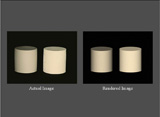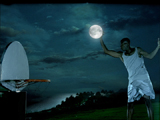Oren-Nayar Reflectance Model |
|||
 |
|||
|
Most reflectance mechanisms can be broadly classified into two categories: diffuse and specular. In computer vision and computer graphics, the diffuse component is often assumed to be Lambertian; a surface that obeys Lambert's Law appears equally bright from all viewing directions. This model for diffuse reflection was proposed by Lambert over 200 years ago and has been perhaps the most widely used reflectance model in vision and graphics.
For several real-world surfaces, however, the Lambertian model can prove to be a poor and inadequate approximation of the diffuse component. The deviation from Lambertian behavior can be significant for a variety of real materials such as concrete, plaster, sand, etc. The primary reason for this deviation is the roughness of the surface. We have developed a comprehensive model for diffuse reflectance that can be viewed as a generalization of Lambert's Law. The model is valid for a wide range of surface roughness values and takes into account complex geometrical effects such as masking, shadowing and interreflections between points on the rough surface. Extensive experiments have been conducted by the CAVE laboratory as well as other research groups to verify the accuracy of the model. Today, the Oren-Nayar model is frequently used in the creation of animations and special effects in movies. The model is available in most commercial rendering software such 3ds Max from Autodesk (formerly Discreet), Maya from Alias and Renderman from Pixar. |
|||
Publicationsprint_paperentry_byid: more than 2 or no entry matches. |
|||
Pictures |
|||
Videos
|
|||
DatabaseCuRRET: Reflectance and Texture Database |
|||
Related ProjectsBidirectional Texture Function |


